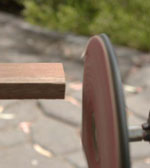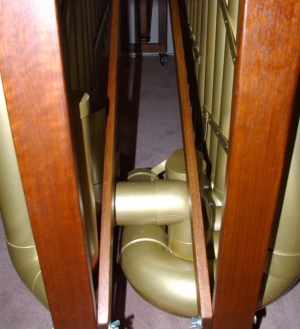Frequently Asked Questions about Making Marimbas...
Do I need special wood for the bars?

The great thing about this project is that it will work for you, no matter what wood you have available. This project is aimed at those who want a concert quality instrument so the wood you use for the bars IS important. It is discussed in great depth in the guide. Commercial marimbas are usually made from Honduras Rosewood or African paduk, and obviously the better wood you have access to the better instrument you’ll be able to make. However you can make this instrument from just about any hardwood (eg, Durian or Meranti) if you want to save money - and it will still work. And there's nothing to stop you making cheaper bars to start with then better ones from more expensive timber later on! The bars in the prototype are made from African Paduk - and you can hear how good they sound in the video higher on this page.
How much will the materials Cost?
Depending on where you live you should be able to get all the materials you need for way less than $2K - and that includes using more expensive timber for professional level bars. Of course this will be way less if you use cheaper timber or if you build an instrument with a lesser range than the full five octaves. Other than bar timber - all the materials can be purchased from the local hardware store.
Does the plans include both Metric and Imperial Measurements?
YES! The plans include both imperial (feet and inches) and metric (millimetres) measurements.
Do I need to be good at woodworking to achieve this?

Absolutely not! I’m not a carpenter - I’m a musician. Most of the skills required are fairly basic woodwork – measuring, cutting and sanding.
Even if you’ve hardly ever picked up a hammer or a saw in your life I’m confident that you’ll be able to achieve a great instrument using these plans. Of course even though I'm not a carpenter, I've picked up a few clues over my time designing and building instruments - but I've put all the important construction tips in the package for you.
Do I need lots of expensive tools?
Absolutely not! All of the tools you will need are common houshold tools.
Things like:
- An electric drill with a sanding attachment
- A screwdriver
- A wood saw
- A small hammer
- Sandpaper and sanding discs
- Hacksaw
- Rivet Gun
Plus a few other bits and pieces commonly found around the garage!
Do I need any special tuning equipment?

Obviously the better your tuning, the better yoiur instrument will sound. It IS possible to tune a marimba purely by ear, but at least a basic electronic tuner is highly recommended. Any chromatic tuner will do the job, and you can get a really basic electronic tuner from any music store for around $50, or simply borrow one from a friend to get the job done! These tuners are incredibly common – nearly all professional musicians or music teachers either own one or have a friend who owns one.
BUT... if you don’t have access to one, don’t worry – as I’ve included a full set of sine waves (clear and clean tones) that you can use to tune the notes by ear. If you have a musical ear it is really easy to do it this way.
If you want to make life even easier, and get a fully professional tuning result, Peterson make tuning software you can buy online for less than $100 USD - which is PERFECT. All these various options are thoroughly discussd in the building guide.
Is my homemade instrument going to sound as good as commercially available instruments?
With THIS building guide - that is certainly possible!
If you use the same timbers as commercial manufacturers do and tune your bars as reccomended in this guide - then there's no reason why your marimba can't sound JUST as good!
Does it matter what the resonators are made out of?
This is definitely one of the biggest areas of misunderstanding for most people.

The fact is that it makes very little difference!
Comercial instrument manufacturers will often TALK about the sounds of different resonator materials - they want to make their instruments seem more special - BUT have you EVER seen anybody publish an actual audio comparison?
and think about it......The resonator's job is to amplify the sound – and it does this by containing a column of air which is the correct size to resonate when sound waves from the bar enter it.
So... does the column of air really care what is containing it? or does it even know? Remember it’s the column of air that is vibrating.. not the container, so what it's made from really makes very little difference!
and I've heard people argue that certain materials are a little harder and reflect sound better than others - well this is true... but here's the thing...
Extra hard metals etc only make a difference at quite high frequencies - the frequencies way above the range of marimbas. Only the upper harmonics of marimbas are in this frequency range - and guess what... these upper harmonics are actually tuned to NOT resonate in the tubes!!!
The plans included for this instrument use PVC pipe for the resonators because:
- They are lightweight
- They are inexpensive
- They are easy to work with
- They don’t require heavy duty hardware to hold them in place
And you can get PVC pipe at just about any hardware store, as it is usually used for drainpipes around just about any home! Of course - if you really want to use different materials for your resonators, there's absolutely nothing stopping you. The building guide still tells you how to get the result you are after.
Do I have to wait for anything to be shipped to me?
Absolutely not! You have instant access to the e-book and videos via download, so you can get started immediately. The plans print out in Adobe Acrobat Reader (which is a free download, and nearly every computer already has it installed anyway).
Can I adapt these plans to build a different range instrument (not 5 Octave)?
Yes Absolutely! In fact this design is called the P524 because it was created with all the possible ranges from five octaves to four octaves specifically in mind. And because the guide takes the approach of actually showing you how to find the critical measurements you need, they are all just as easy - and you could even make a bigger or smaller instrument just as easily!
How Much do these plans Cost?
Your P524 Marimba building guide is just $73 USD If you are not in the USA - You can just go to www.xe.com and check it out in your currency.
and this is actually a tiny price for the plans when you consider:
- The length of time that I had to study acoustics, as well as research and develop building techniques in order to bring these plans to you
- The massive content - 170 A4 sized pages packed with detail including over 800 photos and diagrams AND the almost 2 hours of video going through all the bar tuning processes step by carefull step.
- The trial and error that I went through in designing frames, tuning bars and resonators and selecting materials, that you don’t have to!
- The money you will save on your instrument - even just the money you will save on wasted materials by NOT making the mistakes that I've already made FOR you!
- The absolute impossibility of finding this information out through other sources – I scoured books and the internet for AGES – and the information you need to build a fully professional concert marimba yourself is simply not available anywhere but here.
So go ahead right now and click here to get instant access to the building Plans for this Awesome Professional Marimba
|